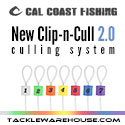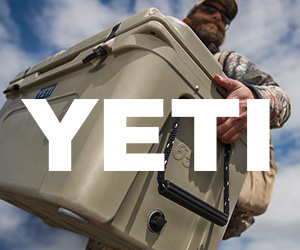 Casting
cont'd: Many swimbait fanatics rely on round reels like the Shimano Calcutta
or Daiwa Luna, which have plenty of line capacity, a muscular drag, and
full-bodied gearing. We found the GLoomis Muskie MUR844C we used in the majority
of our tests to be a little overkill, but it casted the DOA effortlessly. We
cast this lure parallel to or right on top of submerged structure when targeting
bass, and into more open water when pursing stripers. You can try and match the
hatch with the DOA, but with only four patterns your choices are somewhat
limited. If you want to go for quality over quantity the 6 inch DOA is your best
bet.
Casting
cont'd: Many swimbait fanatics rely on round reels like the Shimano Calcutta
or Daiwa Luna, which have plenty of line capacity, a muscular drag, and
full-bodied gearing. We found the GLoomis Muskie MUR844C we used in the majority
of our tests to be a little overkill, but it casted the DOA effortlessly. We
cast this lure parallel to or right on top of submerged structure when targeting
bass, and into more open water when pursing stripers. You can try and match the
hatch with the DOA, but with only four patterns your choices are somewhat
limited. If you want to go for quality over quantity the 6 inch DOA is your best
bet.

The Ayu model in the lab
Retrieving: Once you
have the lure out in the water the real fun begins. The DOA rests at an arc with
the head and spinner tail downwards when at rest. With just a slight twitch of
the rod the lure comes to life, and really looks like a flailing injured fish.
The lip makes the DOA’s head move to the side with short jerks. The blade tail
doesn’t really spin unless the lure is retrieved or jerked aggressively forward.
The lure doesn’t put a lot of noise in the water like some plugs which may even
feature an internal knocker, instead the DOA relies on flash and side to side
splashing in the water to attract fish.

A closer look at the joints
When retrieved briskly the
DOA will drop right under the surface and the tail will move side to side
convincingly wit the blade tail spinning like an inline buzzblade. We got almost
all our strikes when the bait was moving, this doesn’t mean a standard retrieve,
just that we had by far more success when the lure was twitched on the surface
rather than at complete rest.

The DOA features a realistic gill
pattern
The DOA can be fished with
either the rod tip up at a slight angle or pointed down while jerking. Unlike
most topwater plugs that I retrieve back to the boat in bursts we found that
effectively fishing the DOA was more about positioning and twitching. By being
patient and really working the surface of the water between your initial
splashdown and the boat or shore you will maximize the chances that a fish will
view the DOA as easy prey.

Each DOA comes with a oversized
snap
Our theory is that unlike
some other louder baits that incite reaction strikes, the DOA can attract fish
that may not be as aggressive. Fish may take more time to observe the DOA
splashing about on the surface, before they commit to a strike. Because we
observed this behavior we would move the bait forward 10 feet at a time back to
the boat, then patiently jerk the rod tip ever so slightly to bring the bait to
life in a near stationary position on the surface. The technique proved
effective for both largemouth and stripers.

The buzzblade tail attachment is
reinforced with a screwed in plate
When fish do commit they did
so aggressively, especially stripers. During our tests stripers slammed the lure
causing big splashes, sometimes rolling over on the lure as they shot up at it.
The strikes we witnessed had the fish coming in at the lure at a 40 degree angle
rather than straight up from underneath the lure. When the stripers are very
aggressive and there is some wind breaking the surface of the water we also
found shifting to a more aggressive constant jerk-jerk retrieve drew even more
strikes.

The DOA on our G.Loomis Muskie
test rod in the Delta
When both largemouth and
stripers hit the DOA you will know it. The large hooks on the lure do a good job
hanging on to fish, but you will get the occasional short strike. With the DOA
we did not find a violent hookset effective at landing any more fish, in fact we
found just the opposite. By being overzealous with the set we found we actually
dislodged fish that hadn’t got their mouths around the center of the bait. When
a fish hits the DOA simply retrieve on your reel to maintain resistance and bear
down on the fish, once the fish reacts you can give the rod a quick jerk to
ensure the fish is pinned on.

The lip is extra thick for
durability


























